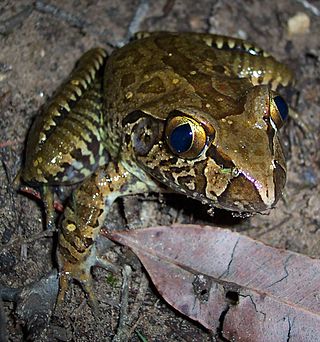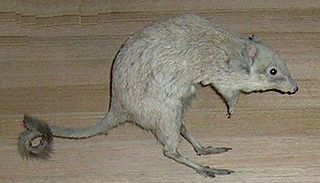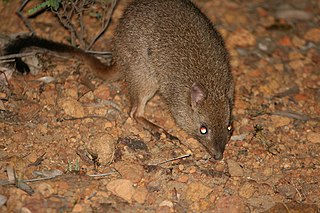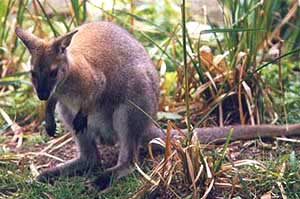
Brisbane Water National Park is a national park on the Central Coast of New South Wales, Australia. The national park is situated 70 kilometres (43 mi) north of Sydney and 12 kilometres (7.5 mi) southwest of Gosford. It consists the Brisbane Water and Mooney Mooney Creek waterways.

The Nightcap National Park is a national park situated within the Nightcap Range in the Northern Rivers region of New South Wales, Australia. The 8,080-hectare (20,000-acre) park was created in April 1983 and is situated 35 kilometres (22 mi) north of Lismore. The park was established following campaigns and blockades against logging at Terania Creek, Grier's Scrub and Mount Nardi between 1979 and 1982. Sections of the Whian Whian state forest were added to it following blockading and campaigning in 1998. The national park is classed by the IUCN World Commission on Protected Areas as Category II and is part of the Shield Volcano Group of the World Heritage Site Gondwana Rainforests of Australia inscribed in 1986 and added to the Australian National Heritage List in 2007.

Conondale National Park is 130 km north of Brisbane in the Sunshine Coast Hinterland near the town of Conondale in the south east Queensland bioregion. The park covers an area of 35,648 hectares protecting large areas of subtropical rainforest, woodlands, wet and dry sclerophyll forest including Queensland's tallest tree. The park contains areas of regenerating forest which have been previously logged; areas of forest plantations also border the park. The park is currently managed by the Queensland Government under the Nature Conservation Act 1992.

The broad-faced potoroo is an extinct potoroid marsupial that was found in southwestern Australia. The first specimen was collected in 1839, and described by John Gould in 1844. Only a small number of specimens have been collected since. The last live capture was in 1875. Subfossil remains indicate that it had an extensive distribution around the semiarid coastal districts of Southwest Australia.

Potoroidae is a family of marsupials, small Australian animals known as bettongs, potoroos, and rat-kangaroos. All are rabbit-sized, brown, jumping marsupials and resemble a large rodent or a very small wallaby.

The tiger quoll, also known as the spotted-tailed quoll, spotted-tail quoll, spot-tailed quoll, spotted quoll, spotted-tailed dasyure, or tiger cat, is a carnivorous marsupial of the quoll genus Dasyurus native to Australia. With males and females weighing around 3.5 and 1.8 kg, respectively, it is the world's second-largest extant carnivorous marsupial, behind the Tasmanian devil. Two subspecies are recognised; the nominate is found in wet forests of southeastern Australia and Tasmania, and a northern subspecies, D. m. gracilis, is found in a small area of northern Queensland and is endangered.

The bridled nail-tail wallaby, also known as the bridled nail-tailed wallaby, bridled nailtail wallaby, bridled wallaby, merrin, and flashjack, is a vulnerable species of macropod. It is a small wallaby found in three isolated areas in Queensland, Australia, and whose population is declining. In early 2019 the total population of the species was estimated to be fewer than 500 mature individuals in the wild and 2285 in captivity.

The woylie or brush-tailed bettong is a small, critically endangered mammal native to forests and shrubland of Australia. A member of the rat-kangaroo family (Potoroidae), it moves by hopping and is active at night, digging for fungi to eat. It is also a marsupial and carries its young in a pouch. Once widespread, the woylie mostly died out from habitat loss and introduced predators such as foxes. It is currently restricted to two small areas in Western Australia. There were two subspecies: B. p. ogilbyi in the west, and the now-extinct B. p. penicillata in the southeast.

The desert rat-kangaroo, also called the buff-nosed rat-kangaroo, plains rat-kangaroo or oolacunta, is an extinct small hopping marsupial endemic to desert regions of Central Australia. It was first recorded in the early 1840s and described by John Gould in London in 1843, on the basis of three specimens sent to him by George Grey, the governor of South Australia at the time.

The musky rat-kangaroo is a small marsupial found only in the rainforests of northeastern Australia. First described in the later 19th century, the only other species are known from fossil specimens. They are similar in appearance to potoroos and bettongs, but are not as closely related. Their omnivorous diet is known to include materials such as fruit and fungi, as well as small animals such as insects and other invertebrates.

The long-nosed potoroo is a small, hopping mammal native to forests and shrubland of southeastern Australia and Tasmania. A member of the potoroo and bettong family (Potoroidae), it lives alone and digs at night for fungi, roots, or small insects. It is also a marsupial and carries its young in a pouch. The long-nosed potoroo is threatened by habitat loss and introduced species such as cats or foxes. There are two subspecies: P. t. tridactylus on mainland Australia, and P. t. apicalis on Tasmania, with lighter fur.

Gilbert's potoroo or ngilkat is Australia's most endangered marsupial, the rarest marsupial in the world, and one of the world's rarest critically endangered mammals, found in south-western Western Australia. It is a small nocturnal macropod that lives in small groups.

The northern bettong is a small, endangered, gerbil-like mammal native to forests in northeast Australia. A member of the rat-kangaroo family (Potoroidae), it moves by hopping and lives in burrows, feeding at night on roots and fungi. It is also a marsupial and carries its young in a pouch. The northern bettong is threatened by habitat loss, and is now restricted to a few small areas.

Potoroo is a common name for species of Potorous, a genus of smaller marsupials. They are allied to the Macropodiformes, the suborder of kangaroo, wallaby, and other rat-kangaroo genera. All three extant species are threatened by ecological changes since the colonisation of Australia, especially the long-footed potoroo Potorous longipes (endangered) and P. gilbertii. The broad-faced potoroo P. platyops disappeared after its first description in the 19th century. The main threats are predation by introduced species and habitat loss.

The Macropodiformes, also known as macropods, are one of the three suborders of the large marsupial order Diprotodontia. They may in fact be nested within one of the suborders, Phalangeriformes. Kangaroos, wallabies and allies, bettongs, potoroos and rat kangaroos are all members of this suborder.

The boodie, also known as the burrowing bettong or Lesueur's rat-kangaroo, is a small, furry, rat-like mammal native to Australia. Once common throughout the continent, it is now restricted to a few coastal islands. A member of the rat-kangaroo family (Potoroidae), it lives in burrows and is active at night when it forages for fungi, roots, and other plant matter. It is about the size of a rabbit and, like most marsupials, carries its young in a pouch.

The rufous rat-kangaroo or rufous bettong is a small, jumping, rat-like marsupial native to eastern Australia. It is the only species in the genus Aepyprymnus. The largest member of the potoroo/bettong family (Potoroidae), it is about the size of a rabbit. The rufous rat-kangaroo is active at night when it digs for plant roots and fungi, and like other marsupials it carries its young in a pouch. Though its range is reduced, the population is healthy and stable.

The Cathedral Range State Park located in Victoria, Australia, approximately 100 kilometres (62 mi) north-east of Melbourne. It is situated between the towns of Buxton and Taggerty and runs parallel to the Maroondah Highway. The Cathedral Range was declared a State Park on 26 April 1979. It consists of 3,577 hectares and contains the rugged Razorback and spectacular peaks of the Cathedral Range, Little River and forested hills of the Blue Range. Due to its proximity to Melbourne the Cathedral Ranges are a popular destination for both day and weekend adventures. Bushwalking, camping, rock climbing and abseiling are some of the more popular activities available. Cathedral Range State Park is listed as Category II under the IUCN World Commission on Protected Areas and is an example of a park that can be used for recreation, education and conserving natural ecosystems.

Calaby's pademelon, also known as the alpine wallaby, is a species of marsupial in the family Macropodidae. It is endemic to Papua New Guinea. It is threatened by habitat loss and hunting.



















